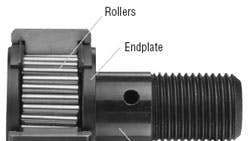A crowning achievement for cam followers
Under load, a cam follower bearing deflects at the bearing stud. This deflection affects the load distribution over the rollers and over the length of each roller, which, in turn, affects the bearing’s rolling contact fatigue life. Calculating load distribution reveals how much a crowned outer ring can improve bearing life.
Follower fundamentals
Removing a section of the outer ring of a cam follower bearing reveals the rollers that separate the outer and inner races. The stud consists of a shaft and integral inner race.
In use, the stud threads into a hole in a support structure. A nut, tightened onto the threaded portion of the stud, locks the cam follower against axial movement, and a slip or press fit on the smooth portion of the stud prevents radial movement. A cam or track bears against the OD of the outer ring, and motion of the cam or track causes the outer ring to rotate. Cam follower bearings carry load from the cam or track to the support structure while allowing relative motion between the cam and the support structure.
The stud of a cam follower bearing acts as a cantilever beam because support comes from one end only. If the outer ring remains aligned with the cam, the resulting misalignment between the inner and outer races creates corner loading of the roller. This misalignment and corner loading increase stresses on the more heavily loaded end of the roller and ultimately decreases the rolling contact fatigue life of a cam follower bearing.
Standard cam follwer bearings come in two types, crowned and uncrowned. The curvature of the crown, created by precise grinding, allows the outer ring to remain aligned with the rollers rather than with the cam. Because of this, bearing manufacturers recommend specifying cam follower bearings with crowned outer rings to carry heavy loads.
Finite element model
A finite element model (FEM) of a cam follower bearing includes a cam on which the outer ring rides, and which applies load to the bearing. Although not shown, the FEM also includes the support plate, into which the stud is threaded.
In the FEM, contact elements simulate the support of the stud by the support plate and simulate the application of load to the outer ring by the cam. Spar elements simulate the cylindrical rollers and consist of beam elements with a gap element at each end. Therefore, the spars can carry compressive forces only, as a roller would. The analyst must choose the stiffness of the spars to match the stiffness of the two Hertzian line contacts between each roller and the stud, as well as each roller and outer.
Crowning cuts deflections
A cross-sectional view of a cam follower bearing with an uncrowned outer ring uses a color code to represent vertical displacement. In this case, the displacement ranges from about –0.0014 in. and less in dark blue, to 0.0003 in. and greater in red.
The striped contours on the stud indicate continuously increasing deflection from the inboard to outboard ends, whereas the outer remains predominantly blue. This indicates that the outer portion moves nearly uniformly downward and remains aligned with the cam. (The picture exaggerates the scale of the displacements to display the misalignment between the stud and outer ring.)
In the cross-sectional view of the outer ring and cam follower bearing stud with a crowned outer ring, both the stud and the outer ring have striped contours. This characteristic indicates increasing displacement from inboard to outboard end. The model shows much lower misalignment between the outer ring and the stud.
Rolling contact fatigue life
Here we see the lives calculated for a cam follower bearing with an uncrowned outer ring, crowned outer ring, and a conventional roller bearing with an inner ring resting on a shaft supported on both ends. To compare apple to apples,the outer ring is not supported in a housing.
A comparison shows that life more than triples by using a cam follower bearing with a crowned outer ring instead of one with an uncrowned outer ring. So perhaps you should ask yourself if you should be specifying cam follower bearings with a crowned outer ring: As pointed out here, the advantages are clear.
